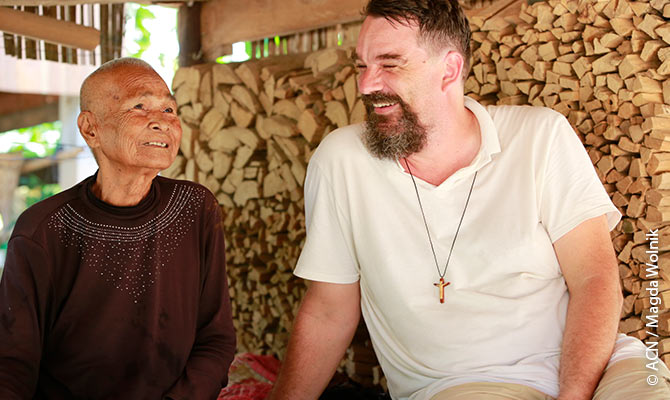But then, thirty years ago, the devastated Church experienced a rebirth in a country in which the majority of the population belongs to the Buddhist faith. Today, the Catholic community remains a tiny minority; however, it has become integrated into the country, as is shown by a series of six short films produced by the Catholic Radio & Television Network (CRTN) for Aid to the Church in Need (ACN).
“A very small group.” These are the words used by Italian missionary Father Luca to describe the Catholic Church in Cambodia. He has been working in the country for many years and was given the opportunity to speak in one of the reports that were filmed for the pontifical foundation ACN. According to the missionary, “Catholics make up only 0.15% of the population in Cambodia, a country in which Buddhism is the state religion of 90% of its people.”
The Catholic Church in Cambodia has come a very long way. During the Pol Pot regime (1975-1979), all religious and traditional cultural customs were suppressed, including both Buddhist and Christian religious observances. Nearly all churches were destroyed during this time, and a large number of priests and religious died. As presented in the reports, the Catholic community was among the hardest hit: 50% of its members died.
In 1979, the war between Cambodia (which was called Democratic Kampuchea at the time) and Vietnam was followed by a civil war, which lasted until the late 1990s. Cambodia was ruled by Vietnamese communists from 1979 to 1989, and all forms of religious practice remained prohibited during this period. After the fall of the regime, Cambodia officially recognised the presence of Christians in the country on 7 April 1990. Seven days later, now thirty years ago, divine services were publicly celebrated – a first in this country in over fifteen years. The services that were held were the celebration of Easter vigil, and this date will be remembered as a sign of the rebirth of the Church in Cambodia. At the time, 3000 Catholics were living in the country.
One of them was an older woman who had been the only Catholic in her village of Prek-Toal for fifteen years. The village is made up of houses built on bamboo rafts moored at the mouth of a river which flows from Battambang to Tonlé Sap Lake. “There were no priests, there was no Christian community to support her. However, at Christmas she gathered her neighbours together to celebrate the birth of Jesus with her,” explained missionary Father Totet Banaynaz. Since then, a mobile floating church has been built. Fifty baptized people live in the village and each year, a growing number of children and adults are preparing themselves for baptism and Holy Communion.

For thirty years, the Catholic Church, which counts slightly over 20,000 members in majority Buddhist Cambodia, has been working to promote the faith, remaining true to the doctrine of the Church, while at the same time making the parables of Christ understandable for the local village population. This was confirmed by Bishop Schmitthaeusler, Apostolic Vicar for the Cambodian capital of Phnom Penh. “When I arrived here, it was Christmastime, and I thought that it would be good to enact the Christmas story. The people are very impressed by our acting skills. I then realised that the time was right for big stage productions and to begin with what l would call evangelisation through art.” He believed that this approach would be the most expedient. “Art runs in the blood of the Cambodian people. For all of the people here, both children and adults, it is absolutely natural to dance and to sing,” the bishop said, explaining how the rich artistic and cultural heritage of Cambodia could be used for evangelisation purposes.
The bishop then went on to point out the importance of maintaining mutual respect between the different denominations. The Bible was translated into the Khmer language, which is also beneficial to the theatre. The bishop explained, “The people come here and see that we respect their culture. Many of them are Buddhists. However, little by little, they are coming to understand the meaning of the gospel.” He added, “We are gradually getting a feel for how art, evangelisation and respect for the culture can all work together to help us understand one another.”
In spite of everything, the scars left behind by the many years of dread and horror are still palpable in Cambodia’s Catholic community. Many churches were destroyed, others were desecrated. Father Totet Banaynaz talked about a church that had been built in 1881 by French missionaries. The church may not have been destroyed; however, during the Pol Pot regime, it was turned into “a completely profane place, which does not inspire even the slightest respect and was used as a cow barn and later as a rice mill. There is absolutely nothing holy left in this church anymore.”
Today, it will not be possible to renovate the church without help from outside. Therefore, the priest invites all “who would like to become active as missionaries with us” to get involved in the project. He added, “We have something that we can give to them: the example of our lives, our simplicity and our suffering. I always say to the faithful here: no one is so poor that he is unable to give. And no one is so rich that he is unable to receive.”
After Christianity was officially recognised in Cambodia in 1990, the right to freedom of religion was adopted in the new constitution that was ratified in 1993. Diplomatically, Cambodia and the Holy See officially recognised one another on 25 March 1994. In the course of these developments, foreign missionaries were once more permitted to come to Cambodia. A Cambodian priest was consecrated in July 1995, the first in 22 years. Over this entire period, ACN has provided ongoing aid for pastoral work to support the regeneration of the Catholic Church in Cambodia.